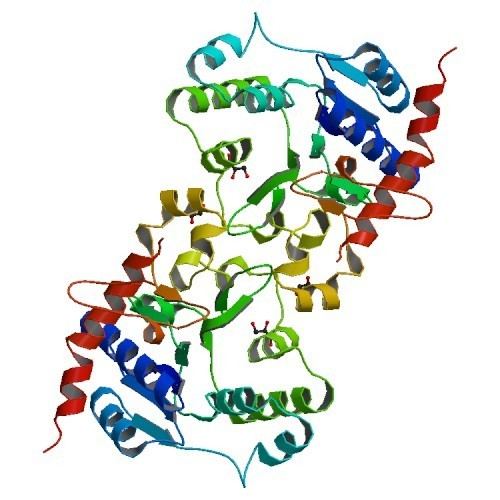Symbol ? | CAS number 117590-73-5 | |
 | ||
Glycogenin is an enzyme involved in converting glucose to glycogen. It acts as a primer, by polymerizing the first few glucose molecules, after which other enzymes take over. It is a homodimer of 37-kDa subunits and is classified as a glycosyltransferase.
Contents
It catalyzes the chemical reaction:
UDP-alpha-D-glucose + glycogeninThus, the two substrates of this enzyme are UDP-alpha-D-glucose and glycogenin, whereas its two products are UDP and alpha-D-glucosylglycogenin.
Nomenclature
This enzyme belongs to the family of glycosyltransferases, specifically the hexosyltransferases. The systematic name of this enzyme class is UDP-alpha-D-glucose:glycogenin alpha-D-glucosyltransferase. Other names in common use include:
Discovery
Glycogenin was discovered in 1984 by Dr. William J. Whelan, a fellow of the Royal Society of London and current professor of Biochemistry at the University of Miami.
Function
The main enzyme involved in glycogen polymerisation, glycogen synthase, can only add to an existing chain of at least 4 glucose residues. Glycogenin acts as the primer, to which further glucose monomers may be added. It achieves this by catalyzing the addition of glucose to itself (autocatalysis) by first binding glucose from UDP-glucose to the hydroxyl group of Tyr-194. Seven more glucoses can be added, each derived from UDP-glucose, by glycogenin's glucosyltransferase activity. Once sufficient residues have been added, glycogen synthase takes over extending the chain. Glycogenin remains covalently attached to the reducing end of the glycogen molecule.
Evidence accumulates that a priming protein may be a fundamental property of polysaccharide synthesis in general; the molecular details of mammalian glycogen biogenesis may serve as a useful model for other systems.
Isozymes
In humans, there are two isoforms of glycogenin — glycogenin-1, encoded by GYG1, and expressed in muscle; and glycogenin-2, encoded by GYG2,and expressed in the liver and cardiac muscle, but not skeletal muscle. Patients have been found with defective GYG1, resulting in muscle cells with the inability to store glycogen, and consequential weakness and heart disease.
